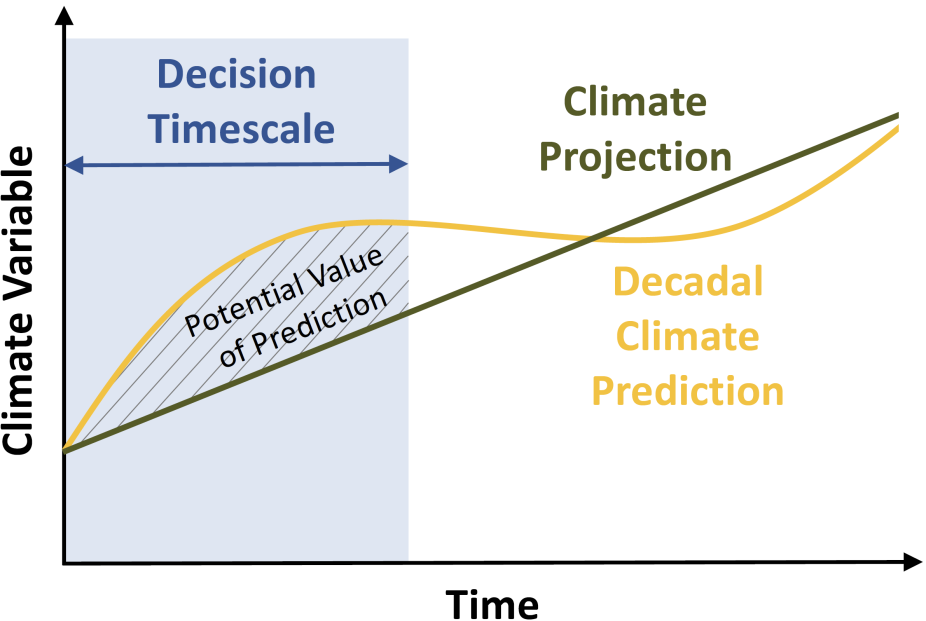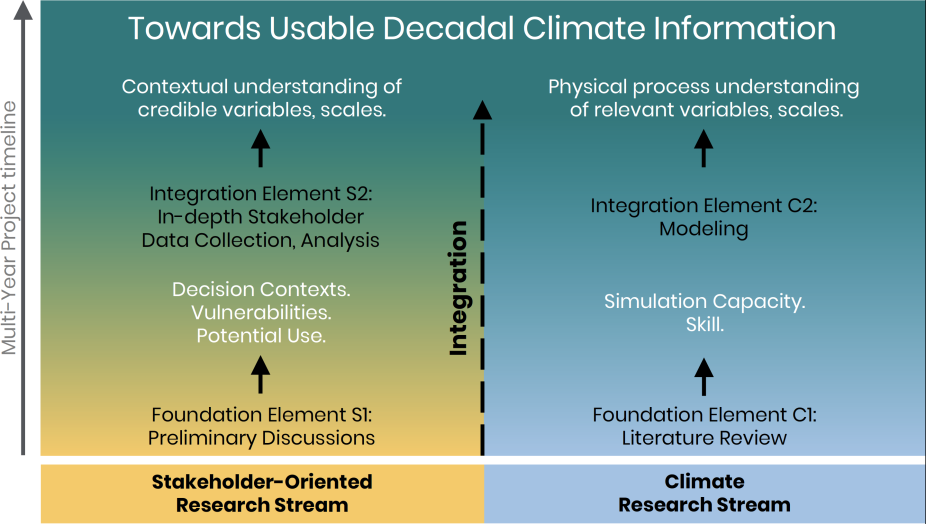Understanding Decision-Climate Interactions on Decadal Scales (UDECIDE)
UDECIDE was a multi-year project that ran from 2014 - 2020, funded by National Science Foundation Decadal and Regional Climate Prediction using Earth System Models (EaSM-3) grants AGS-1419563, AGS-1419558 and AGS-1419504.
Decadal climate predictions provide climate information one to ten years in the future, and bridge the gap between seasonal forecasts and climate projections. While the use of seasonal and climate outlooks has become mainstream across various sectors of climate risk management, the societal value of these decadal climate predictions is relatively unexplored. The potential value of predictions over climate projections is depicted in Fig. 1. This project identified new opportunities for creating usable climate information that arise from the decadal timescale.

Figure 1. A schematic representation of a climate projection (green) compared with a decadal climate prediction (yellow). The potential value of the prediction is depicted as the difference between the projection and the prediction over the timescale of a planning decision (diagonal line shading). Typically, ensemble approaches are used, but here single predictions and projections are shown for clarity. Figure taken from Done et al. [submitted]
A novel interdisciplinary research framework was implemented to help work towards realizing usable decadal climate information. We focused on case studies of flood risk and water resource management in Colorado and California.
The framework (Fig. 2) consisted of a stakeholder-oriented research stream and a climate research stream that became increasingly combined as the project progressed. Foundation elements of each research stream mapped the landscapes of the current state of decadal climate science and decadal-climate related stakeholder decisions. Later, integration elements were where the research streams became combined, towards the creation of usable climate information.

Figure 2. Research framework to work towards creating usable decadal climate information. A stakeholder-oriented research stream produces knowledge about decision contexts, vulnerabilities, and potential uses, while a climate research stream produces knowledge about simulation capacity, skill, and process-level understanding. The two research streams exchange information and become increasingly integrated throughout the multi-year project. Figure taken from Done et al. [submitted]
For water resource management we found broad scope for integrating decadal climate predictions into decisions, particularly for California that experiences the strongest and most well understood decadal variability.
From this starting point, our climate research indicated that the connection between California precipitation and the potentially predictable ocean temperature patterns may be stronger than currently thought. We also found that decadal variability in mean precipitation over California manifests as changes in the frequency of the strongest storms.
We used these new climate science results to inform the design of presentations of decadal prediction data, and discussed these with stakeholders in California to explore how decadal predictions could be provided in usable ways.
We identified many potential uses including prioritizing near-term investments, avoiding stranded assets, and facilitating difficult conversations with stakeholders about how to manage competing demands on resources.
Further, we found that multi-year predictions of extreme seasons may provide opportunities to test new management strategies.
This project successfully converged stakeholder-oriented research and climate research: We advanced the physical science by understanding decadal variability at the scales most desired by the stakeholders.
The framework is general and could be applied to other climate regions and decision contexts. The rapid evolution of decadal climate science and availability of real-time predictions, combined with clear societal need, is presenting new opportunities to create usable climate information.
Recent events such as the Oroville Dam failure in California in 2017 and the devastating wildfire season of 2020 in California and Colorado indicate that creating usable multi-year climate outlooks is more important than ever.